#larvae records
Explore tagged Tumblr posts
Text
Reportagem: Carcass, Rotten Sound e Brujería no Hard Club, Porto
A segunda noite da passagem em Portugal da tour Europa Rigor Mortis foi no Hard Club no Porto, com uma sala esgotada.

A banda de grindcore Rotten Sound foi quem abriu as hostilidades, após a sua passagem avassaladora em 2023 . São uma verdadeira máquina de brutalidade sonora e não deram tréguas do início ao fim.

Já com uma carreira sólida na cena, presentearam-nos com uma excelente performance e o público esteve em total sintonia com a banda, com um espírito agressivo e autêntico, impecável. Quem esteve lá, saiu com a sensação de ter feito parte de um momento único de puro grindcore.
Setlist Self Power Pacify Equality | Koiranoksennus Suburban Bliss Renewables Lazy Asses Inhumane Treatment Targets Void Insects Ownership Sharing Nothingness Slay Western Cancer Sell Your Soul Salvation Trashmonger Blind
Já os Brujeria, ficamos com a sensação que deixaram um pouco a desejar. Esta tour, para eles, está a funcionar como uma espécie de homenagem depois de duas perdas de extrema importância na sua formação, Juan Bruno e Ciriaco “Pinche Peach” Quezada, e infelizmente sentiu-se realmente que algo falta, parece menos atrativo do que outrora fora.

De notar que a setlist no Porto foi mais curta também do que na atuação do dia anterior em Lisboa.
Setlist Brujerizmo Christo de la roca Hechando chingasos (Greñudos locos II) El desmadre La migra Colas de rata La ley de plomo Consejos narcos Raza odiada (Pito Wilson) Matando güeros Marijuana
Eis que chega a hora de Carcass, que iniciaram a atuação precisamente à hora marcada. Uma verdadeira celebração da história do metal extremo, uma exibição magistral de técnica e intensidade. Desde o momento em que a banda entrou em palco, ficou claro que estavam ali para dominar e a receção do público foi um reflexo da longevidade da banda.

A energia da plateia foi tão intensa quanto a da própria banda, Jeff Walker, com sua presença de palco inconfundível, manteve o público agarrado à performance. O som estava muito nítido, permitindo que não se perdesse a brutalidade que caracteriza a banda. Para quem é fã, foi mais uma demonstração da sua brutalidade, e para quem não conhecia (achamos que ninguém), uma verdadeira revelação da grandiosidade dos artistas.

Sem dúvida, um espetáculo que reafirma a relevância e a força dos Carcass no cenário do metal.
Setlist Buried Dreams Kelly’s Meat Emporium Incarnated Solvent Abuse No Love Lost Tomorrow Belongs to Nobody/Death Certificate Dance of Ixtab Black Star / Keep on Rotting in the free world Genital Grinder Pyosisified Exhume to Consume 316L Grade Surgical Steel This Mortal Coil Corporal Jigsore Quandary Ruptured in Purulence Drum Solo Heartwork
Galeria Completa
Texto e Fotos: Rita Mota
#musicshooters_pt#live music#2025#portugal#reportagem#concertos#carcass#rotten sound#brujería#hard club#larvae records#sonic slam
2 notes
·
View notes
Text
Album Review: Lord Sin - Confessions (Larvae Records)
Crushingly heavy, devilishly dark, and filled with all kinds of dramatics, the album is a tome even though it only has six tracks.
Formed in 2020, the enigmatic duo known as Lord Sin is back with their highly anticipated new album ‘Confessions’, set to be released on December 13th via Larvae Records. Not only mysterious because their identities are hidden, but because the style of music they play combines electrifying psychedelic with dark doom. Lord Sin are an intriguing listen, offering up an album that stands out for its…
0 notes
Text

tma fans please advise
#i wish i was making a stupid fandom reference for clout on the internet but Alas#this has been getting steadily worse for the last three months#every day is truly a new disaster at Pet Food Store#tma#tw bugs#tw worms#red legged ham beetles and associated larvae if you wanted to know#which you probably didn't.#for the record#we have had exterminators out#and mostly it is getting better#but the Wet And Cold made them flare back up this last week ugh
13 notes
·
View notes
Text
Presently going insane rn:

Anyway let me talk about the one question that I have been contemplating ever since I began rotating petrosapiens in my mind. How the fuck do babies?
If you caught the reblog before this post, you might have noticed that a post about fat in aliens brought me to think about petrosapien fat, which contradicts a lot of what I've already established for them being an exoskeletal species, let alone being a hard sell in the sci-fantasy of rock crystal people of canon. Turning to one of my two animal inspirations of petrosapiens - bugs and more specifically in this case insects - I found out that insects can't build up fat, not in the way mammals or reptiles can, BUT they store the most of it in a very significant stage;
Larvae!
Then it fucking hit me, I already made some early headcanons about child development in petrosapiens (though I can't remember if I posted them or had a post ready to send) where they were already in a metamorphosing stage, though the responsibility fell solely to the layer who would use crystallokinesis to feed an 'egg'. I didn't fully like the idea though mostly in retrospect, because it felt strange in the 'pulled out of my ass' kinda way, a method of child rearing that felt more obligated to use crystallokinesis as a primary source for feeding to sorta justify at the time the inherent power petrosapiens have towards crystallokinesis.
Instead, between then and now I fully connected the idea that crystallokinesis is less of a power and more of an extension of a petrosapien's nervous system, compression of quartz through the use of a more electrical based nerve network that happens to not distinguish between person crystals and the similar crystalline structures of Petropia. With this in mind and the new idea that petrosapiens have larvae, wouldn't it be so cool if the larvae had the typical Earth-like electrochemical nervous system of humans (or I suppose bugs here) that adapts to an electrical focused nervous system through the process of metamorphosis? Where the larvae creates it's petrosapien crystal skin by building a chrysalis and melting within it to create their new body?
Unlike my old headcanon where the layer had to remain with the egg and constantly feeding them with crystallokinesis, this larvae version can feed itself when provided and so long as the chrysalis is well protected, the moment metamorphosis stage takes place the parent(s) can have momentary reprieve from child rearing and better prepare themselves for the toddler/adolescent stage for their child. The little grub probably doesn't even eat crystals in the early stages of their larvaehood since eating crystals initially marks as the materials for chrysalis building before it becomes a nutritional food source. Instead the little grub might be feed plants and potentially animal products in order for it to inherit and develop the chemicals required to build a crystallovorous stomach and the acids used to break silica down into digestible nutrition.
That does mean that early child rearing is a little bit more functionally deadly towards the very crystalline parents, who have to legitimately watch so that their fingers aren't bitten off, but holding the little grub is easy when it's covered in silicone membrane. The larvae at this stage is a little bit more resistant to any crystallovorous plant secretions due to the polymers of it's membrane, as well as the higher diversity of oxygen, hydrogen, and carbon in it's body it has in comparison to adults or adolescents who've undergone metamorphosis, their innards becoming a more uniform silicone and their skin being the crystalline silicon many crystallovorous stomachs have adapted to eat.
It also means that the shape of a grub is also considered to be cute to a petrosapien. Things from caterpillars to maggots look so much more charming to a petrosapien's eyes that back on Petropia there would be a large proportion of pet owners having what would considered on Earth to have bugs for pets. In fact, a rather common form of pet Petrosapiens might have would be a large millipede/centipede like animal that would be the size approximate of a feather boa and often held that way too, because while they do not undergo metamorphosis, they look like a larval grub well into adulthood and are considered to be very cute for it. Pet owners with these pets who are also parents love to see their little larvae and their 'dog' getting along and would love telling their adolescent all the cute stories of the little grubs curled up against each other. Petrosapiens in the age of the Surface Craze might have had the opportunity to get a few baby pictures like that, and it would be considered very cute unless you were a human afraid of bugs or not personally a fan.
Petrosapiens on Earth might see the miniature bugs and explode with cuteness overload, others might fuck around and find out that they can make human-petrosapien hybrids Makarat you chupacabra you're lucky petrosapien kids aren't born with crystals pay child support to your human wife who birthed a grub-!
And that's the post send tweet-
#petrosapien#ben 10#xenobiology#at this point i only think about petrosapiens as bugs rarely as reptiles- maybe i should add more reptile stuff#like leathery eggs that the grubs eat their way out of yeah let's add that#since the larvae don't have powerful enough stomachs to eat crystals yet let alone the jaw strength#which looking at a grub you can see the vague body plan of a petrosapien#the opening face- the significantly more developed rear legs (present as 'swimmerets')-#you can (mostly) tell from even the grub stage that your kid's a guy or a girl because they even have the nubs for back spines in grub stag#even if it turns out to be an excess/lack of 'testosterone' or an intersex trait#it was their grubs that petrosapiens were even able to connect themselves to old fossil records-#an extinct shrimp or prawn type thing that shares similarities to their little grub- though already with armour or even exoskeleton#also this grub thing makes the crystal twins slightly less of a hassle at least for the still unnamed human mother because i suck at names#means lucía had a grub for a twin sister for a hot while- nor did the family have much in the way for crystal for blanca to eat#so instead of crystals blanca ate bones for her chrysalis and hey look she's bone white now which- oopsie osteokinesis#no matter all the crystallokinesis that happens is with lucía and oof ouchie it's scoliosis#well- replacing keratin AND scoliosis but woopsie#that should be in an oc post
19 notes
·
View notes
Text

3 notes
·
View notes
Video
tumblr
Wow, I got footage of a hairy woodpecker wresting an insect larva out of a tree and then whacking the crap out of it 😮
#backyard birds#birds#birdlr#birblr#woodpecker#hairy woodpecker#bird#nature#OBAB Photography#I was really lucky with this shot#I heard some knocking on the tree while I was doing yardwork and I happened to have my camera nearby#then I recorded this video and soon afterward the woodpecker flew away with its meal#I didn't know such large larva live in the tree 🤯
18 notes
·
View notes
Text











Dragon: Tirrin - Sandsurge Auraboa XXY Female
(Auraboa scroll applied on 2023-12-12) (Caterpillar scroll applied on 2023-12-12) (Larvae scroll applied on 2023-12-12) (Topcoat scroll applied on 2023-12-12)
Purchased For: 75,000 treasure Hatched On: 2023-11-05 ID: 90317810
Parentage: Navajo/Kokopelli Flight: Arcane
Primary: Fire Sailfish Basic Caterpillar Secondary: Fire Marlin Basic Larvae Tertiary: Marigold Fishbone Basic Topcoat Eyes: Common
Comments: Purchased as a mate for Terren.
Apparel:
Accent: Ceadchosach
Familiar: Crowned Gryph

Progeny Testing:
[Test] Terren
Broods:
Paired with Terren on 2023-12-12, 2 eggs [Clutch]
Matched with Terren on 2024-01-03, 3 eggs [Clutch]
Bred with Terren on 2024-02-03, 3 eggs [Clutch]
Crossed with Terren on 2024-03-27, 1 egg [Clutch]
Joined with Terren on 2024-06-19, 3 eggs [Clutch]
Mated with Terren on 2024-09-15, 1 egg [Clutch]
#Tirrin Dragon#Dragon Queen#Dragon Record#Auraboa Female#Auraboa Breed#Orange Pool#Ancient Dragons Pool#XXY#Fire#Caterpillar#Caterpillar Fire#Larvae#Larvae Fire#Marigold#Topcoat#Topcoat Marigold#Arcane Flight#Common#Crowned Gryph
0 notes
Text
A reef that has been degraded—whether by coral bleaching or disease—can’t support the same diversity of species and has a much quieter, less rich soundscape.
But new research from Woods Hole Oceanographic Institution shows that sound could potentially be a vital tool in the effort to restore coral reefs.
A healthy coral reef is noisy, full of the croaks, purrs, and grunts of various fishes and the crackling of snapping shrimp. Scientists believe that coral larvae use this symphony of sounds to help them determine where they should live and grow.
So, replaying healthy reef sounds can encourage new life in damaged or degraded reefs.
In a paper published last week in Royal Society Open Science, the Woods Hole researchers showed that broadcasting the soundscape of a healthy reef caused coral larvae to settle at significantly higher rates—up to seven times more often.
“What we’re showing is that you can actively induce coral settlement by playing sounds,” said Nadège Aoki, a doctoral candidate at WHOI and first author on the paper.
“You can go to a reef that is degraded in some way and add in the sounds of biological activity from a healthy reef, potentially helping this really important step in the coral life cycle.”
Corals are immobile as adults, so the larval stage is their only opportunity to select a good habitat. They swim or drift with the currents, seeking the right conditions to settle out of the water column and affix themselves to the seabed. Previous research has shown that chemical and light cues can influence that decision, but Aoki and her colleagues demonstrate that the soundscape also plays a major role in where corals settle.
The researchers ran the same experiment twice in the U.S. Virgin Islands in 2022. They collected larvae from Porites astreoides, a hardy species commonly known as mustard hill coral thanks to its lumpy shape and yellow color and distributed them in cups at three reefs along the southern coast of St. John. One of those reefs, Tektite, is relatively healthy. The other two, Cocoloba and Salt Pond, are more degraded with sparse coral cover and fewer fish.
At Salt Pond, Aoki and her colleagues installed an underwater speaker system and placed cups of larvae at distances of one, five, 10, and 30 meters from the speakers. They broadcast healthy reef sounds – recorded at Tektite in 2013 – for three nights. They set up similar installations at the other two reefs but didn’t play any sounds.
When they collected the cups, the researchers found that significantly more coral larvae had settled in the cups at Salt Pond than the other two reefs. On average, coral larvae settled at rates 1.7 times (and up to 7x) higher with the enriched sound environment.
The highest settlement rates were at five meters from the speakers, but even the cups placed 30 meters away had more larvae settling to the bottom than at Cocoloba and Tektite.
“The fact that settlement is consistently decreasing with distance from the speaker, when all else is kept constant, is particularly important because it shows that these changes are due to the added sound and not other factors,” said Aran Mooney, a marine biologist at WHOI and lead author on the paper.
“This gives us a new tool in the toolbox for potentially rebuilding a reef.”
Adding the audio is a process that would be relatively simple to implement, too.
“Replicating an acoustic environment is actually quite easy compared to replicating the reef chemical and microbial cues which also play a role in where corals choose to settle,” said Amy Apprill, a microbial ecologist at WHOI and a co-author on the paper.
“It appears to be one of the most scalable tools that can be applied to rebuild reefs, so we’re really excited about that potential.”"
-via Good News Network, March 17, 2024
#coral#coral reef#marine life#marine biology#conservation#ecology#environment#environmental news#endangered species#coral bleaching#virgin islands#science and technology#climate action#climate change#climate hope#soundscapes#sound therapy#good news#hope
2K notes
·
View notes
Text
Fish of the Day
Today's fish of the day is the lake sturgeon!
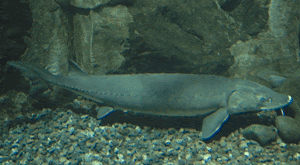
The lake sturgeon, also called the rock sturgeon, and known by scientific name Acipenser fulvescens is one of the best known North American sturgeon species! Found in and around the great lakes, and then across the Mississippi river and Erie canal. Found in 5 differing Canadian provinces and across 24 states stretching from Alabama to Michigan, and as far East as New York. These fish are benthic, spending their time along the bottom of the lake bed, but during spawning these fish will migrate thousands of miles to go back to the stream they were born in.

Like all sturgeon, they are considered living fossils, as sturgeon first appeared in the fossil record upwards of 150 million years ago, with the fish now appearing nearly identical to these ancestors. These fish can get 7 feet or longer, with most being only 4 to 6 feet in length, making them some of the largest sturgeon in North America. Their diet is made up of various invertebrates such as: larvae, small crustaceans, and worms, which they can find along the benthic lake and river beds. The 4 barbels found on these fish have taste buds, which are used to determine what is under their mouth, before they use their prehensile lips to suck up food. When food becomes scarce, these fish are known for migrating for better feeding, which happens semi frequently around the year.

The life cycle of the lake sturgeon is similar to that of most other sturgeons. They begin life as eggs laid in the location their parents were born, in fast paced river streams with lots of flat rocks. The eggs themselves are a bright yellow color, although as the eggs matures this will turn an olive and eventually brown over the course of about 2 weeks. Then they live as larvae only 10mm long, living in and around the dark underside of rocks. After this, as juveniles they will swim to lake environments, where they will spend the majority of their life cycle. These fish can live 55 years long in males and around 150 years for females, with sexual maturity being achieved at an age of around 10 years in males and 30 years in females. Breeding and spawning only happens intermittently every handful of years, and go through around 10 spawning seasons throughout their lifecycle.

For a fun fact to end on for these fish because I'm particularly fond of them, when they reach the stream they will spawn in, these fish are known to porpoise, jumping several feet into the air to end their long journey. That's the lake sturgeon everybody! Have a wonderful day!
#lake sturgeon#rock sturgeon#sturgeon#sturgeons#fish#fish of the day#fishblr#fishposting#aquatic biology#marine biology#freshwater#freshwater fish#animal facts#animal#animals#fishes#informative#education#aquatic#aquatic life#nature#river#ocean
191 notes
·
View notes
Note
Many parasites takeover the minds and bodies of insects, spiders or other creatures, making them like zombies. You’ve listed some in spider-ween and other places. Do you know any parasites that take over bees? I know wasps lay their eggs in their larva, but haven’t really found anything about those that pilot a bee’s body.
Strepsipterans! Also frequently just called "Stylops"
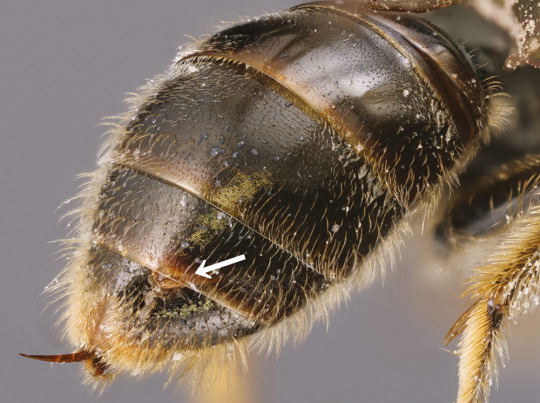
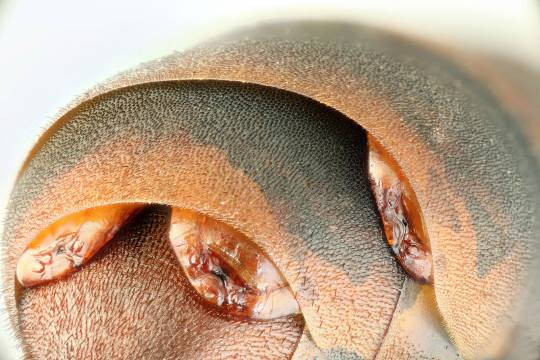
These are the weirdest most alien insect group in existence. What you're seeing are the head ends of the mature females; their bodies are just bags of tissue that absorb nutrients from the host, so they no longer have any trace of limbs or wings and their flat little heads no longer have mouths or eyes.
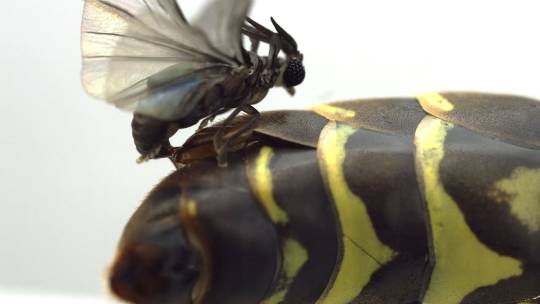
The only reason the female's heads stick out of the host at all is because the head evolved into the end they mate with. The short-lived mature male is a very tiny flying thing (whose anatomy is unlike any other insect alive today - a totally unique type of wing, unique eye arrangement, we have NO idea what these evolved from, except for some loose connections to beetles!) who mates by breaking through the female's featureless armored face with his bladed genitalia and then he dies. And Strepsiptera can be found infecting all sorts of arthropods, even apparently some arachnids, but none of those arthropods really tend to sit still when a little tiny flying man tries to land on them, so the females usually do something to their hosts (we aren't sure what exactly) to make them slower and more complacent. Social Hymenoptera like bees are especially common hosts though, and when a worker bee or wasp is infected by stylops, she actually abandons her colony and her duties for extended periods of time to just perch in one place while the parasite broadcasts its mating pheromones. This is especially eerie from the bee's perspective; a worker bee is a female bee that wasn't allowed to become a queen and isn't "supposed" to be going around mating, but now she's sitting around waiting for a male just like any other bug that wants to be a mom. It's just not a male of her species and she's not the one who gets to reproduce. Is the parasite tapping into buried queen behavior? Does the bee's little brain think it's calling for a drone to help it start a new hive? Or does the parasite just make the bee a lazy slob who stops caring about her hive and just feels like chilling out on a flower all day? We might never know.
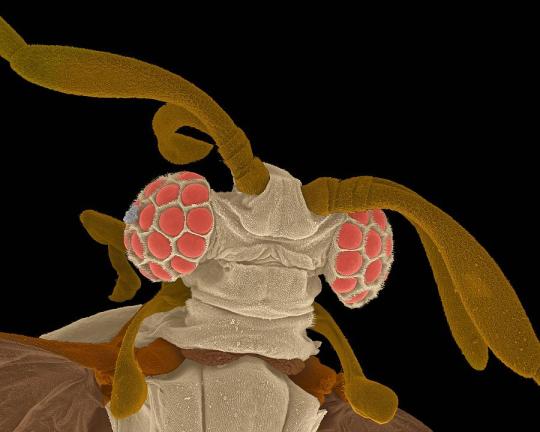
Here are those unique eyes of the male for anyone wondering. Not set in a fine multifaceted grid like in other insects, but clustered, still set in their own individual "sockets" like we see in much more ancient arthropods like trilobites! This suggests that Strepsipteran eyes date back to when insects were first beginning to evolve towards true compound eyes, but there still aren't many insects in the fossil record that have anything else in common with these animals. EDIT: oh yeah I forgot to include that these are in the children's book made by @revretch and I!
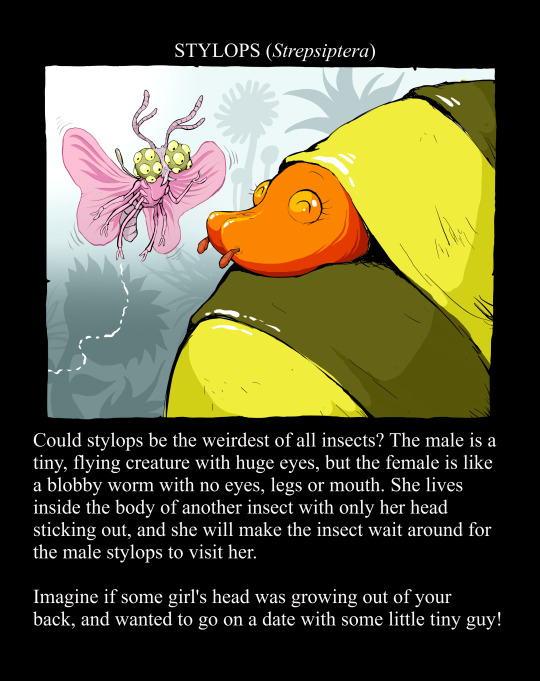
I did the rough pencil sketch of this page while Rev did the beautiful inks! I felt kids should know about these animals but I tried to explain it in the most kid-friendly way possible.
2K notes
·
View notes
Text
Carcass, Brujería e Rotten Sound passam por Portugal em duas datas a não perder!

As lendas do death metal Carcass, os mestres do death/grind Brujería e os titãs do grindcore finlandês Rotten Sound estão prontos para incendiar os palcos já no dia 28 de Janeiro no Hard Club, no Porto (alteração de espaço), passando também por Lisboa (no Music Station) no dia anterior. Num evento único, os 3 titãs do grind/death juntam-se numa de duas noites que simplesmente não podes perder!
Carcass prometem uma performance brutal e energética, trazendo os seus riffs cortantes e vocais poderosos que nunca deixam ninguém indiferente. Brujería, com letras provocativas e som avassalador, vão agitar os fãs com clássicos como “Matando Güeros” e “Raza Odiada”. Rotten Sound, que celebram 30 anos de carreira, vão apresentar faixas do seu último álbum “Apocalypse”, além de clássicos que definiram o género grindcore.
Esta é uma oportunidade única para assistir a 3 grandes concertos do metal extremo, numa noite que promete muita intensidade e revolta.
Bilhetes à venda na BOL e locais habituais, com bilhetes muito limitados.
Parceria: Sonic Slam e Larvae Records
Vê aqui os horários atualizados:

0 notes
Text
Random Doctor Who Facts You Might Not Know, Part 69
One time while escaping from a cell, Romana commented that it would be child's play to unlock the door with her sonic screwdriver. She then said it was literally child's play as doing so had been a game back on Gallifrey. (Audio: Subterranea)
One of Jamie's distant relations became a spy during World War II and used the name "the Doctor." (Audio: Operation Werewolf)
On his report, Borusa gave Theta Sigma a 7 in the subject of "Physical Inactivity." He commented that his pupil seems to think he is a mountain goat. (Short story: Report on Term's Work)
Memory lanterns are Time Lord devices that resemble paper lanterns but record an individual's thoughts and memories. During the Time War, many Gallifreyans released these lanterns as a desperate ploy to not be forgotten, as they thought they would all die. (Novel: Engines of War)
Ben, Polly, and Jamie played with a ouija board on the TARDIS. This caused a dark cloud from the time vortex to slip inside Jamie's mind, affecting his behavior. The Second Doctor banished the cloud by reading a recipe for Bajaxx stew written in Ancient Gallifreyan. (Short story: Something at the Door)
Jarra To killed the previous overseer of the Axis. Eventually, a Time Lord came to investigate, but they killed them. By the time the Fifth Doctor and his companions landed there, they described the corpse as "rank" with oozing flesh and insect larvae. (Audio: The Axis of Insanity)
After leaving Nyssa, Tegan, and Marc behind, the Fifth Doctor had several adventures on his own. Eventually, he encountered his Eleventh self, and he decided to return to his companions because he didn't want to be like him - companionless and disparaged in 1892. (Audio: Thin Time)
Time Vortex leeches live in the time vortex, and the Doctor had thought they were a myth from Ancient Gallifreyan songs until one of them clung to his Eleventh self's TARDIS exterior. (Comic: Space in Dimension Relative and Time)
One time, a man called Gaylord Lefevre played a game of cards against the Toymaker. He cheated and used a needle to mark cards, but the Toymaker was aware of this and altered his cards to be a hand full of jokers when Gaylord wasn't looking. The Toymaker claimed he wasn't cheating but instead following a new rule that Gaylord had introduced - that cheating was acceptable. (Comic: The Greatest Gamble)
Gallifrey has a transtube, which is basically an underground train. It has a central station under the Capitol. (Novel: The Ancestor Cell)
One time after the Seventh Doctor was knocked out, he drowsily told Ace that he had had a terrible dream. A man with ringlets had been reaching out to him, saying, "Come in, Number Seven, your time is up." He was talking about the Eighth Doctor. (Audio: The Silurian Candidate)
Maria Mazzini once commented on how powerful the Fifth Doctor's thighs were - after slapping them. (Audio: Serpent in the Silver Mask)
One time, the Fourth Doctor decided to take Sarah Jane to Geshtinanna. The journey in the TARDIS took nine weeks, during which both became bored and tired. While traveling in the time vortex, the clocks in the TARDIS all stopped, and the Doctor then detected the remains of another TARDIS in the vortex, trapped their because the pilot had made the mistake of locking their course. They were worried that they too had fallen to the same fate and were unable to change course, but when the day of materialization finally came, they successfully materialized. The Doctor realized that the TARDIS had stopped all the clocks out of respect for her fallen fellow TARDIS. Even after nine weeks of travel, they materialized nowhere close to Geshtinanna. (Short story: Eternity)
The Seventh Doctor has shifted his genetic makeup enough to disguise himself before and mimic someone else. He admitted that he learned this trick from the Master, who frequently used regeneration as a disguise. (Novel: Original Sin)
On Gallifrey, there are two hundred and eight tenses in their languages. They don't translate well. (Novel: The Crystal Bucephalus)
First 1 Prev 68 Next 70
#hahahah way to go fever me for realizing i never posted this#69. nice.#doctor who#dw#dr who#new who#classic who#big finish#big finish doctor who#big finish audios#dw eu#doctor who eu#romana#romana ii#theta sigma#jamie mccrimmon#ben jackson#polly wright#second doctor#fifth doctor#nyssa of traken#tegan jovanka#eleventh doctor#the toymaker#seventh doctor#eighth doctor#ace mcshane#fourth doctor#sarah jane smith#the master
255 notes
·
View notes
Text
Here Are My Top 10 Favourite Ants
(Updated due to public outcry and political pressure.)
No. 10 - Yellow Crazy Ants
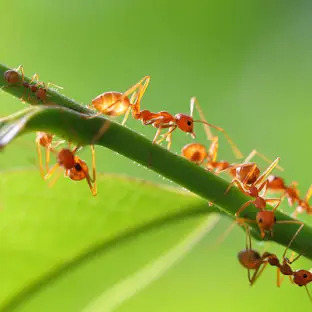
These guys are on a list of "one hundred of the world's worst invasive species" formulated by the International Union for Conservation of Nature (IUCN), having invaded ecosystems from Hawaii to the Seychelles.
But don't hate just because they are awesome at establishing themselves in a new habitat due to their aggression toward other ant species, lack of aggression toward members of their own species, efficient recruitment, and large colony size. Respect the hustle!
No. 9 - Paraponera Clavata
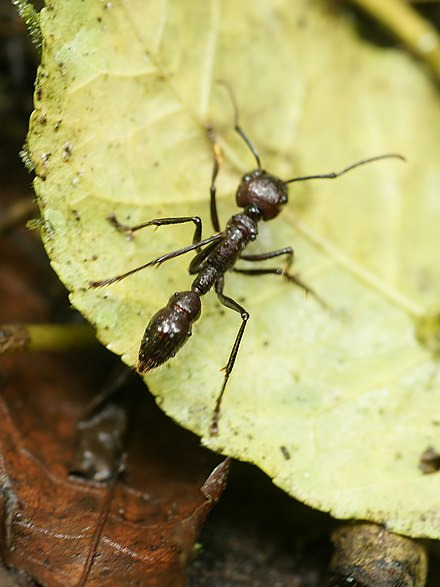
Also known as the "bullet ant," "the one wounding deeply," or "24-hour ant", referring to the full day of pain that follows being stung.
This ant's sting currently ranks the highest of all insect stings on Justin O. Schmidt's informal sting pain index, at 4.0+. Some victims compared the pain to that of being shot, (hence the nickname,) with "waves of burning, throbbing, all-consuming pain that continues unabated for up to 24 hours."
Lymphadenopathy, edema, tachycardia, and fresh blood appearing in human victim feces are common symptoms from even a single sting.
Un-fuck-with-able.
No. 8 - Honeypot Ants
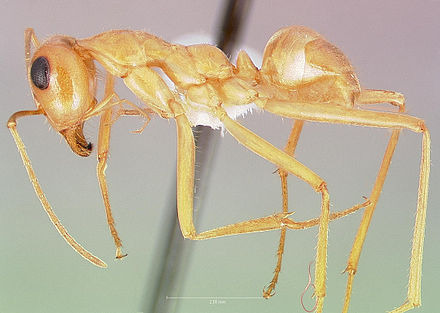
The name honeypot ant comes from the peculiar development of replete workers, whose abdomens become so swollen with food that they are used by the rest of the colony as living food storage. They are "drained" during famine, usually the wintertime, to sustain the colony, leaving them as "flaccid depletes."
Disgusting. 10/10
When a replete worker fills with food, a portion of her digestive tract swells and displaces other abdominal organs. It can expand about four to five times its normal linear dimension when they are fully engorged with food.
I can relate. I have eaten pasta in such quantities to displace my own organs many times.
No. 7 - Red Imported Fire Ants
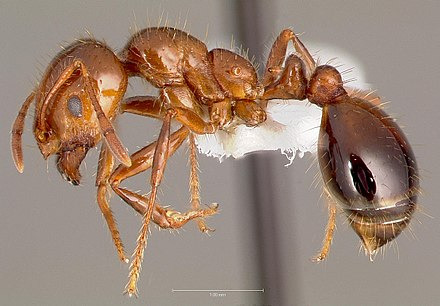
Though South American in origin, the red imported fire ant has been accidentally introduced to many other parts of the world.
More than 14 million people are stung by them in the United States annually. Most victims experience intense burning and swelling, followed by the formation of sterile pustules, which may remain for several days. Up to 6% of people may suffer from anaphylaxis. More than 80 deaths have been recorded from red imported fire ant attacks.
These ants thrive in urban areas. Nests can be built under pavements and foundations. This means not only can they damage or destroy individual structures, but red imported fire ants can have an affect on broader infrastructure, damaging land, business and property values. In agriculture, they can damage crops and machinery, and threaten pastures. They also pose a threat to animals and livestock, capable of inflicting serious injury or death, especially on young, weak, or sick animals.
With annual damages estimated in the billions of dollars, these ants are considered the second worst thing to arrive on North American soil since 1492.
No. 6 - Black Garden Ants
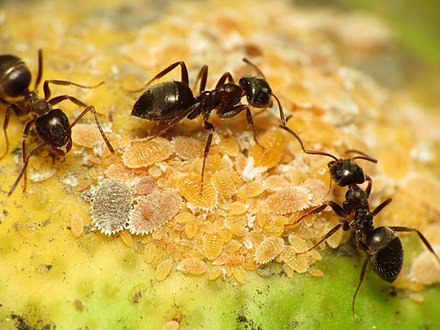
When building their colony, these ants will structure it so as to inhibit the transmission of different contagions. Different communities within the colony are segregated by a limited number of connective nodes, allowing for greater protection of vulnerable hive members, such as larvae and pupae.
A trait I could only wish other species performed so well.
No. 5 - Pharaoh Ants
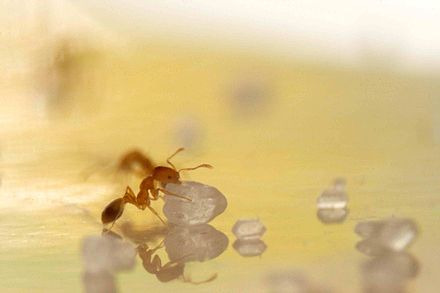
These ants utilize three types of pheromones. One is a long-lasting attractive chemical that is used to build a trail network. It remains detectable even if the ants do not use the trail for several days.
The second pheromone is also attractive, but will decay to imperceptible amounts in a matter of minutes without reapplication. This pheromone is useful in marking food sources as these are unpredictable and liable to change quickly, so not worth the longer-lasting pheremone.
The third pheromone is a repellant. If an individual finds an unprofitable area with little food or significant danger, it will release this repellant pheromone, which will warn others and cause them to look elsewhere. While positive pheromones indicating lucrative foraging sites are very common in social insects, the pharaoh ant's negative pheromone is highly unusual and pharaoh ants were the first species found to employ such a thing.
No. 4 - Argentine Ant

This species is like the Mr. Worldwide of ants. It has established itself in every continent except Antarctica (including many oceanic islands.)
It even has "supercolonies" that extend across hundreds or thousands of kilometers, first reported in California in 2000, then in Europe in 2002, Japan in 2009, and Australia in 2010.
Several subsequent studies used genetic, behavioral, and chemical analyses to show that supercolonies on separate continents actually represent a single global supercolony.
The researchers stated that the "enormous extent of this population is paralleled only by human society."
How can you not admire (and fear) the ambition and the achievement?
No. 3 - Leafcutter Ants
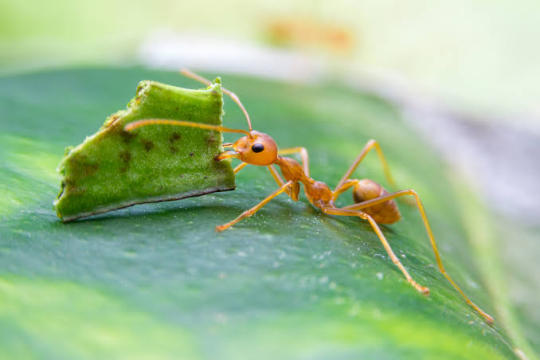
"Leafcutter ants" is a bit of an umbrella term, as it consists of over 45 ant species, but this gang is just so remarkable. Next to humans, leafcutter ants form some of the largest and most complex animal societies on Earth. They are known for their advanced agricultural practices. These ants are not merely foragers but skilled farmers, cultivating their own food by collecting specific kinds of leaf matter in order to produce specialized fungi in their nests.
No. 2 - Formica Fusca
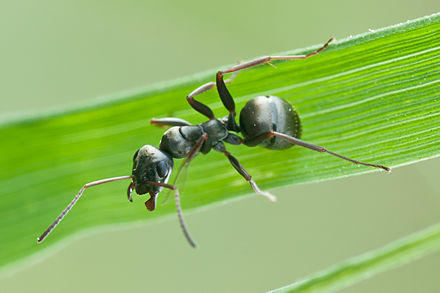
These ants, (sometimes called silky ants or dusky ants,) are fast to learn, and only a single presentation of stimulus is enough for them to form a genuine long-term memory. This formed memory is also resistant to extinction.
Ants of this species can also detect volatile organic compounds emitted by cancer cells. After a 3-trial conditioning, they can differentiate cancer cell lines from healthy ones. They can also differentiate between at least two different cancerous cell lines.
A similar ability to detect human tumours has been shown in more recent studies.
No. 1 - Weaver Ants
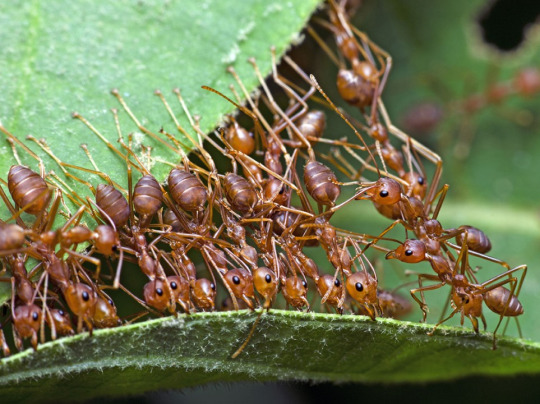
An arboreal species, (i.e. they live in trees,) weaver ants are known for their unique nest building behaviour where workers construct nests by weaving together leaves using larval silk. Colonies can be extremely large consisting of more than a hundred nests spanning numerous trees.
How they sew the leaves together is a remarkable feat of cooperation. Typically, dozens of ants will need to form a chain to first bridge a gap between two leaves, then pull them together so another team can hold them in position whilst yet more ants sew the gap together with silk. But adult ants can't make silk, so they have to use larvae to do it, picking the larvae up and using them like little pots of glue to spin a mat of silk between the two leaves. Altogether, a hundred ants might be involved in the same task. This is a pretty remarkable piece of evolution and a testament to the power of cooperation!

#ants#Myrmecology#bugblr#insectblr#bugs#insects#bug#insect#entomology#ant#antposting#invertebrates#antblr#parasites#parasitism#weaver ant#formica ant#leafcutter#bullet ant#fire ant
212 notes
·
View notes
Note
What does the yotici life cycle look like now?
Fairly similar, here's a generalized idea

I Did kind of drop the sessile+asexual polyp mobile+sexual fish alternating generations because it doesn't Really change anything besides sounding vaguely interesting. Fish reproduction is wild enough as-is.
Their eggs are laid in a stringy mass that requires a root to the sea floor (coral, tough kelps, rocks, sticks, etc) and light currents to keep them oxygenated. These egg masses are strong and can bend and sway fairly significantly without coming apart, but will be broken by strong currents and require a sheltered environment to survive. This is the basis of a Garden, an engineered ecosystem designed to protect the eggs, provide substantial and consistent nourishment for the young and resting places and shelter for adults, and additionally function as cultural and social centers.
Larvae are tiny and born with a yolk sac attached to sustain them. They metamorphose into a 'predatory' phase in which they feed on zooplankton and organic debris. These phases are tiny and poor swimmers, wholly reliant on the sheltered environment of the garden for safety and consistent food sources. Those swept out have very little chance of longterm survival. The VAST majority of yotici that hatch at all die in their larval stages.
Most of their anatomy is fully developed as a 'yotling', in which they are much stronger swimmers, school together, and are primarily predatory. Yotlings feed on plankton and other small animals, but their most important food source is their own species' eggs. This is a natural behavior for yotici, and much of the function of the garden is to provide this dependable, clustered food source for their young. The survival benefits of most of their reproductive output being sacrificed to these viable young with a fairly strong chance of survival vastly outweigh the loss, given the vast majority of yotici larvae who hatch to begin with die without ever reaching this phase. Yotlings have much lower mortality rates than the larvae, but a majority will die to predation. They're also frequent bycatch in fisheries and are widely eaten by landdwelling peoples. During the yotling phase, they're about 4-8 inches long.
Their beak starts to develop in the juvenile stage, during which they are 'weaned' out of predatory behavior and start consuming algae and marine plants. They instinctively school around adult yotici and follow them to food sources, usually eating algae that grows around the tougher foods the adults can handle. This tends to be the point in which active parental protection begins, but few yotici cultures conceptualize these juveniles as full people or develop personalized bonds with them, as their mortality rate is still fairly high. During the juvenile phase, they're about 8-14 inches long.
A yotici 'child' has all its base adult anatomy developed, including its tentacles, and looks like a miniature adult. They can eat tougher foods and join the adults in consuming seagrass. This is the point in which they are semi-equivalent to a human infant, rapidly learning and picking up on language and beginning to communicate. Fully active parental care and bonding will occur during this period (the Exact cultural marker of when this starts can vary) and they are conceptualized as people. Diminishingly few yotici actually survive to this phase, but those who do have a very good chance of lasting to adulthood. The child phase starts at about 1-2 ft in length.
At this point they grow steadily until sexual maturity, and will continue to grow (much, much more slowly) throughout the rest of their lives. Sexual maturity takes a VERY long time, usually about 20 years from hatching. An adult yotici generally ranges in size from 12-18 ft, with outstanding or very long lived individuals passing 25 (the World Record would be in the mid 30 ft range). A yotici who survives to reproductive adulthood has excellent chances at a long life, and yotici are by far the longest living sophonts. A lucky individual can crest 200 years.
#Should note that when I make changes for realism it's not because I think worldbuilding should be hyper realistic to be good but because#like. It's fun for me. I like having to think about these things and having to learn and problem solve to conform to Mostly hard#realism. I only drop things when they're not fun for me and/or I like another option better.#And I let a lot of other things be fully unrealistic with like. A little grounding when adjusting for realism would Not be fun for me#Like the three moons is not even slightly realistic (in that it has like no effects whatsoever on this world which is 99.999% earthlike)#but I like it and think it's fun to have the wrinkle of Three Moons and think about how that could affect cultural interpretations of the#moon so I keep it#etc#yotici
118 notes
·
View notes
Text


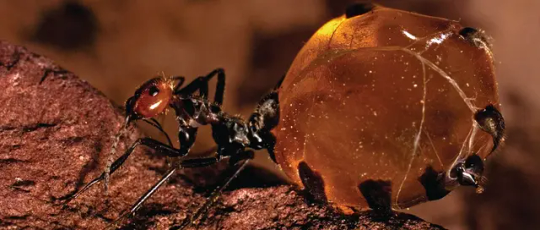
A Sweet Time with the Honeypot Ant
Camponotus inflatus, better known as the Australian honeypot ant or the black honey ant, or the yarumpa or wuukurta ant among Aboriginal Australians, is one of the most well-known members of the honeypot ant group. As their name implies, they are endemic to Australia. They can be found throughout the continent, but are most common in the arid desert and scrubland regions of central Australia.
Honeypot ants, including the Australian honeypot ant, are best known for their specialized worker ants known as repletes. Other castes of workers go out to forage for nectar and honeydew, and bring it back to the colony where it is fed to the repletes. The abdomens of these individuals swell as they are fed, so that they can hold several times their weight in food. In times of shortages, this food can then be regurgitated and fed to the workers and larvae. In addition to its workers, each colony can contain multiple queens; some colonies have been recorded harboring up to 6 queens, presiding over 1,000 workers.
Visually the replete and forager workers are quite similar to each other. Both have black bodies with gold striped abdomens. However workers remain rather small, at only 5-8 mm (0.19 - 0.31 in) in length, while repletes can grow up to 1.4 g (0.03 oz) in weight and about 15 mm (0.59 in) in length. When their abdomens become swollen with honey, they turn transparent to show the amber liquid inside.
Black honey ant nests are most commonly found near or under vegetation, particularly the Mulga bush from which workers harvest most of their food. In addition co collecting nectar from the flowers, workers also collect honeydew secreted by the sap-sucking insects that live in the leaves and roots of the bush. C. inflatus in turn is predated upon by lizards and birds. Many Aboriginal peoples, especially the Tjupan, Mutitjulu, Anangu, Arrernte, and other groups in northern Australia, have also traditionally harvested Australian honeypot ants as a delicacy.
Conservation status: C. inflatus has not been assessed by the IUCN. Its populations are widespread and so believed to be stable. While traditional Aboriginal harvesting has not posed a threat, increased commercial harvest for its pharmaceutical properties may put increased pressure on this species.
Photos
Steve Shattuck
Jean & Fred Hort
Wang & Pan et al.
#Australian honeypot ant#Hymenoptera#Formicidae#carpenter ants#ants#hymenopterids#insects#arthropods#deserts#desert arthropods#scrubland#scrubland arthropods#oceania#australia#north australia#west australia
131 notes
·
View notes
